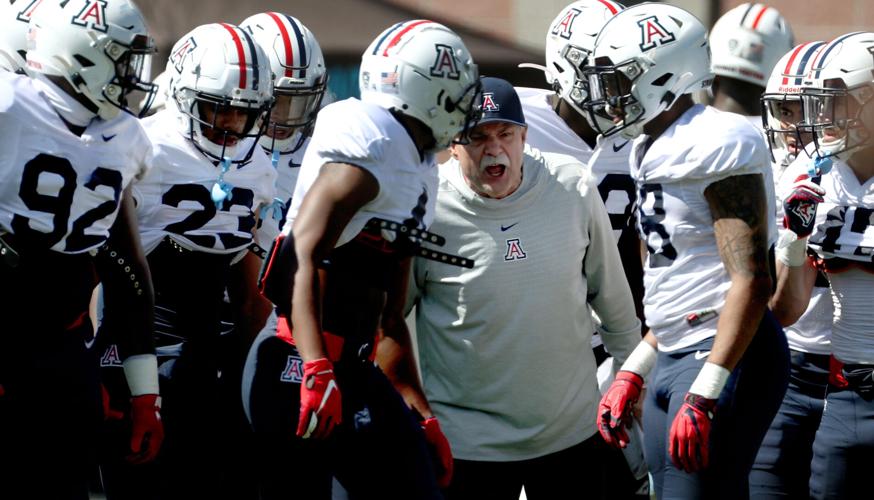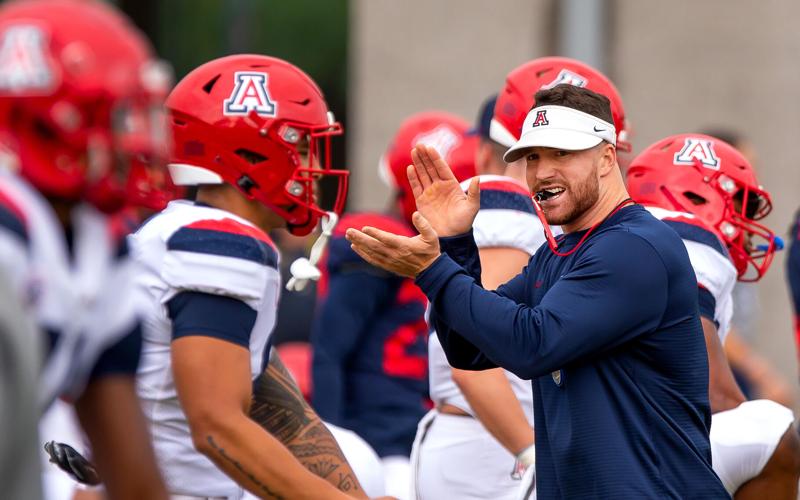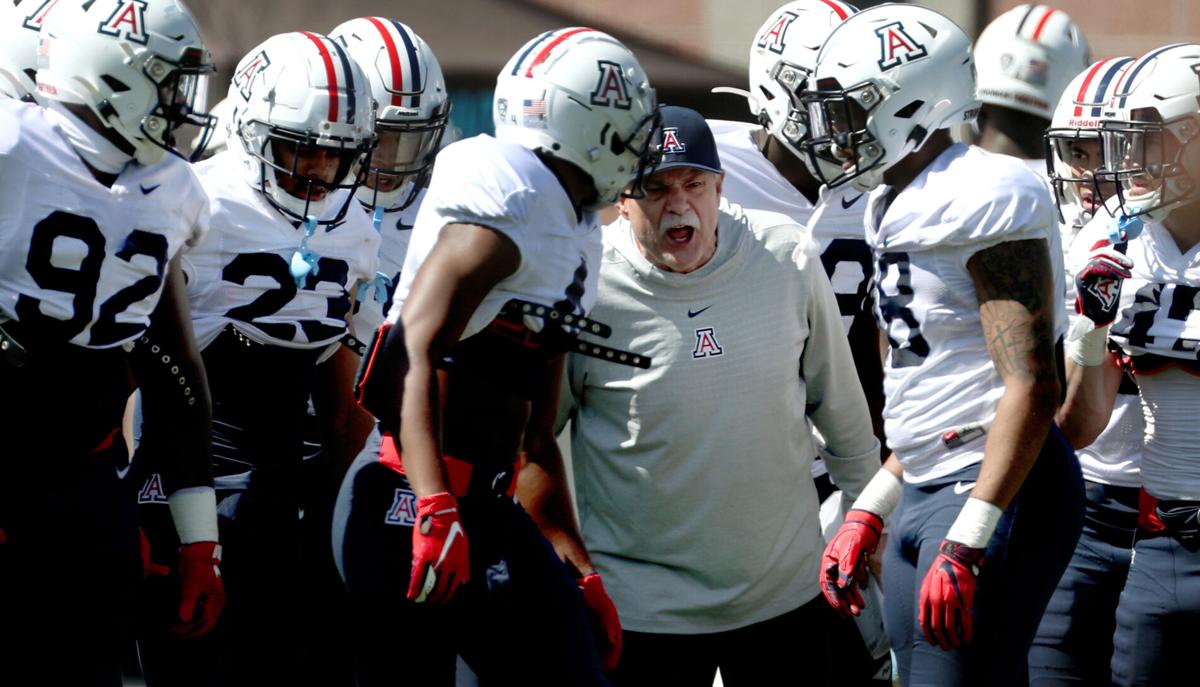The number looming over the 2021 Arizona Wildcats — the one every broadcaster and pundit will cite until it’s no longer relevant — is 12.
If you’re a UA follower, you know what that figure signifies. If Jedd Fisch could just drag it into the recycling bin, he would. But he knows that’s not how losing streaks are broken.
Arizona has to improve in multiple areas to end that skid. The first opportunity comes Saturday night against BYU in Las Vegas.
There’s no sense in dwelling on the school-record slump; the coaches and players — many of whom weren’t around to experience it — certainly haven’t. A more productive exercise is to examine some of the reasons it happened and how something like it could be prevented in the future.
That’s what we’re going to explore in the season debut of “Cats Stats” – five sets of numbers that help explain what got us here and what needs to change (or perhaps already has).

Editor’s note: Each week throughout the football season, we’ll take an in-depth look at the Arizona Wildcats from a statistical perspective.
The number(s): minus-9
The significance: That was Arizona’s turnover margin last season. It was tied for the worst in the Pac-12. (Fun fact: The other team that finished minus-9 was ... conference champion Oregon.)
That figure was inflated by the season finale against Arizona State in which the UA coughed up the ball an astonishing seven times. In the other four games, the Wildcats were minus-2, which isn’t terrible. But given that turnover margin is the one statistic all coaches point to as mattering the most — and given Arizona’s minimal margin for error – it’s not where you want to live.
For the most part during the losing streak, the Wildcats’ giveaways have come in bunches. Their takeaways have been practically nonexistent.
All three last season came in the Colorado game. Arizona had just four over the final seven games of 2019. Since taking the ball away 10 times in the first three games of ’19, the UA defense has forced only eight turnovers in 14 contests.
Enter new defensive coordinator Don Brown and his pressure-oriented scheme. In his four full seasons at Michigan (2016-19), the Wolverines averaged 1.4 takeaways per game. Michigan ranked in the middle of the pack nationally each year. Only once during that span, in 2017, did Arizona rank higher than 97th.
The number(s): minus-16/minus-115
The significance: The first figure is the Wildcats’ sack differential last season; the second is their sack-yardage differential. Both ranked last in the Pac-12. By a lot.
Arizona recorded only two sacks in fives games. The next-lowest total was seven. One of the teams that did it, Cal, played just four games.
Those two sacks netted a mere 3 yards in losses. The next-lowest total was Cal with 31.
In terms of the differentials, the Golden Bears and Wildcats finished at the bottom. But Arizona’s net sacks of minus-16 were double Cal’s (minus-8), and the Wildcats’ lost yardage was more than double (115 vs. 50).
Arizona lost 23 yards per game on plays that resulted in sacks. On the opposite end, Washington — which allowed only one sack in four games — gained 19 yards per contest.
The Wildcats finished 0-5. The Huskies went 3-1.
The overarching goal of Brown’s scheme is to create pressure — or mistakes born from the illusion of it. In his first four seasons at Michigan, the UM defense averaged 3.0 sacks and 20.7 yards in losses per game. The Wolverines ranked no worse than 34th nationally in sacks per game and twice finished in the top 10.
The number(s): 5.6
The significance: That was Arizona’s average gain per pass attempt last season. It was 2 yards lower than the previous year (7.6). But that doesn’t tell the full story.
UA quarterbacks averaged 9.1 yards per attempt in the first five games of 2019, when the Wildcats went 4-1. Over the next seven games – all losses – that figured dropped to 6.5.
Over the course of the 12-game losing streak, Arizona has averaged 6.1 yards per pass attempt. To put that in perspective, the national co-leader last season, Alabama’s Mac Jones, averaged 11.2 yards.
Yards per attempt is a key component in calculating efficiency rating. Jones led the country at 203.1. (He also had the highest completion percentage and one of the best touchdown-to-interception ratios.)
The biggest culprit, in our view, has been pass protection. UA quarterbacks simply haven’t had adequate time to connect with receivers deeper down the field.
The Wildcats surrendered only seven sacks in the first five games of 2019, or 1.4 per contest. Since then? A whopping 44 sacks in 12 games, or 3.7 per contest.
The personnel on the offensive line is mostly the same as last year, but Arizona has a new, pro-style scheme and a new line coach with extensive pro experience (Brennan Carroll). Less pressure should lead to a higher average per pass attempt.

First-year strength coach Tyler Owens has the Wildcats bigger — and presumably stronger — as they head into Saturday’s 2021 season opener against BYU in Las Vegas.
The number(s): 233.5
The significance: That’s the average weight of the players listed on the 2021 online roster. It’s the highest average over the past five seasons.
Now, it isn’t the highest by much. Last year’s average was 232.1.
But if the question is whether the Wildcats truly have gotten bigger under strength coach Tyler Owens — a question one of our Twitter followers posed to us — the answer is yes.
Here are the average weights over the past five seasons:
2021: 233.5
2020: 232.1
2019: 223.4
2018: 230.2
2017: 225.0
Interestingly, this year’s team has the second fewest 300-plus-pound players over that span. Here are those numbers:
2021: 13
2020: 17
2019: 14
2018: 14
2017: 9
The 2016 team had only seven players weighing 300 or more pounds. Kevin Sumlin, Arizona’s coach from 2018-20, made a concerted effort to boost the team’s overall size. That trend has continued.
Bigger doesn’t necessarily mean better. But more muscle mass en masse should help the Wildcats hold up in matchups against the Pac-12’s most physical teams – and against the likes of BYU.
The number(s): 17
The significance: That’s how many players Fisch and his staff added from other FBS schools via the NCAA transfer portal. It’s believed to be one of the highest figures in the nation.
Eight of those players started at least one game at their previous schools and combined for 81 starts. Several are expected to start for the Wildcats, including quarterback Gunner Cruz and cornerback Isaiah Rutherford. Several more will play significant rotational roles.
Arizona has more than 40 newcomers overall, representing more than one-third of the roster. (It’s hard to say precisely what that number is because of the unusual case of receiver Ma’jon Wright, who was with team last year, left and then returned. He counts as a portal addition – yet isn’t exactly a newcomer.)
Even the UA’s football support staff is almost entirely new. Of the 35 people listed in the online directory, which includes coaches, only seven remain from before Fisch arrived.
The point is: This is a dramatically different program from the last time we saw Arizona play a game on Dec. 11, 2020. For everyone who’s new, the only number that matters is one — as in Game 1.







